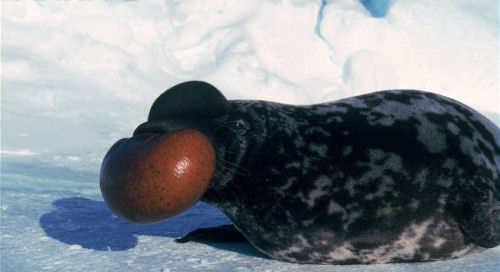Harbor Seal
The Harbor Seal also known as the Common Seal (Phoca vitulina) is incredibly adapted to living in the cold and temperate waters. These animals are common in the northern waters of the Atlantic and the Pacific Oceans.
Males reach a size of 160-185 cm, with females being about 10 cm shorter. Thanks to the thick layer of fat, the Harbor Seals can take the cold weather much more successfully than, for instance, sea lions. The body of these seals is also extreme hydrodynamic, and the grayish combined with black fur provides excellent camouflage in the shore waters of the northern seas. On land, however, they are quite clumsy and move only with small jumps, because their fins are too weak to hold the weight of the body on dry land.
In reality, Harbor Seals rarely come on dry land, spending three quarters of their lives in the water. They’re very social and live in groups near the shores of the northern seas. They can measure great distances in search of rich feeding areas. Their excellent hydrodynamics allow them to swim quite fast, propelling the body with the back fin, swinging it from one side to another, much like an otter, but unlike the sea lions, who swim using the strong neck and chest fins.
The diet of Harbor Seals consists mostly of sea fish, who provide with all the necessary foodstuff to maintain a thick layer of fat. These seals can dive even 200 metres deep to catch a fish. If their favourite dish is not available, they will eat crustaceans and squids.The strong jaws allow the seal to grab and hold even the slipperiest of prey. Harbor Seals have also been mistakenly thought to be responsible for stealing salmons from fishing nets, while study shows that salmons are not actually a part of the seal’s diet.
Mating happens in the middle of the summer. Every year they return to the place they have been born for copulating. These places are mostly sandy beaches or rocky sea cliffs, and the Harbor Seal is the only northern seal who gives birth only on dry land. Males arrive to the spot first and when the females come, they usually bark at each other and try to gain the sympathies of females. After a gestation period of 11-12 months, the females return to dry land shortly before flood tide and usually a single (rarely two) pup is born who immediately starts swimming in the nearby coastal waters. The young seal with his mother still return to dry land time to time to rest and drink milk.
In the sixties, Harbor Seals were widely hunted, because it was thought they destroy large populations of fish, and the pollution of the northern seas has also taken its toll. Fortunately, the cries of natural activists have been heard and the eradication of this species has been put to a stop and currently Harbor Seals have a strong population and are not endangered.




